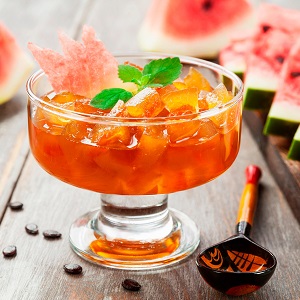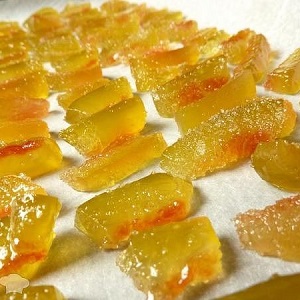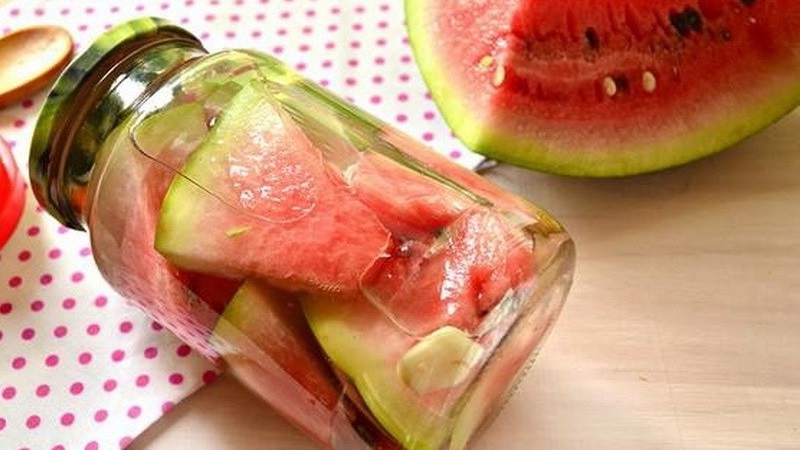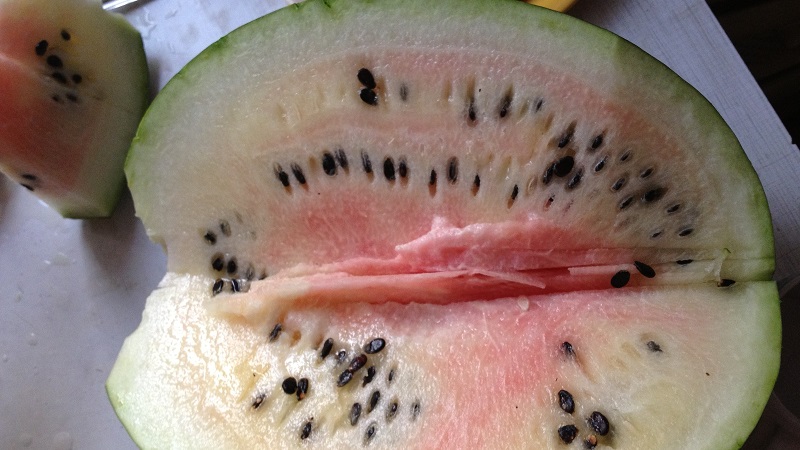Do plucked watermelons ripen at home
What a pleasure it is to enjoy the juicy cool pulp of a watermelon on a hot summer day! A couple of ripe slices will saturate the body with moisture twice as much as a glass of water.
How to choose the right watermelon and can it ripen at home if it lies down? The answers to these questions, as well as what to do with unripe fruits, you will learn from the article.
The content of the article
Do watermelons ripen when plucked?
Sometimes, due to the cold and rainy summer, gardeners have doubts: will the melons in the beds have time to ripen?
Often gardeners pluck unripe fruits in the hope that they will lie down and ripen at home. This assumption is based on the fact that some vegetables (tomatoes, zucchini, melons) ripen during storage.

However watermelon acquires sweetness and aroma only in the garden in the sun... Even for long-term storage, the fruits are laid when they are fully ripe.
Will the cut fruit ripen
Was the cut fruit green? What to do to ripen the watermelon?
The answer is nothing. The pulp will no longer turn red and sweet... But the situation can be corrected by putting the berry into action.
How to use unripe fruits
It is impossible to eat an unripe berry without heat treatment... Jam and candied fruits are made from such a watermelon. Lovers of salty also do not worry about where to attach an unsuccessfully chosen fruit. Here are some universal watermelon recipes for all occasions.
It can be useful:
How to understand that a watermelon has gone bad and what to do if it happened
Unripe watermelon jam
For 400 g of pulp need 0.5 glasses of water, 800 g of sugar, one lemon.
 Preparation:
Preparation:
- Wash the watermelon and lemon thoroughly.
- Peel and seed the berry, cut into pieces 2-3 cm in size.
- Put the workpiece in a saucepan, add a quarter of a glass of water and 250 g of sugar, cook over low heat, stirring occasionally, until the pieces soften (about 45 minutes).
- Meanwhile, peel the lemon and squeeze the juice out of it. Grate the zest on a fine grater.
- Prepare syrup from lemon juice, remaining water and 150 g of sugar.
- Pour the zest into a saucepan, pour in the hot syrup, cook over low heat for another 30-40 minutes. While doing this, gradually add the remaining sugar (400 g) until the syrup thickens.
For winter storage such jam needs to be boiled not for 40 minutes, but for an hour or an hour and a half, and rolled up in sterilized jars.
Candied fruit
Ingredients: one medium-sized watermelon, 0.5-0.8 liters of water, 100-150 g of sugar.
 Preparation:
Preparation:
- Wash the fruit and cut into medium-sized wedges.
- Peel the pieces of pulp and the white strip that is near the rind.
- Cut the crusts into slices.
- Prepare the syrup: pour a layer of sugar about 1 cm thick into the pan, moisten with water and melt, stirring constantly.
- Boil slices of watermelon rind in clean water for 15-20 minutes.
- After that, transfer the crusts to the syrup and cook over low heat for 5-10 minutes.
- Remove, dry the candied fruits in the oven at 50 ° C, and boil again in syrup for 5-10 minutes. Repeat the procedure two times.
After final drying you can try candied fruits.
Salted watermelon in a jar
Take 2 kg of berries 1 liter of water, 70 ml of 9% vinegar, 3 tbsp. l. sugar, 1.5 tbsp. l. salt.
Bring the water to a boil, add sugar and salt, add vinegar, rinse the watermelon thoroughly, cut into small pieces. Place in a three-liter jar and cover with hot brine.
Sterilize jars under a lid for 20 minutes.Then roll up, wrap and leave in a warm place with the lid down. Place the cooled jars in a cellar or a cool pantry.

How to determine ripeness
Knowing the simple signs of ripeness of melon fruits, you can easily choose a sweet and aromatic watermelon.
Determination of ripeness in the garden
It is easier to choose a ripe watermelon on your own garden, because the gardener knows exactly when the crop is planted, and in the cousse, what is the average growing season for his variety. Such signs will help to recognize the ripe berry.:
- dry tail means that the fruit has stopped feeding and "disconnected" from the melon, which means that it is ripe;
- a rich yellow or orange spot on the side lying on the ground;
- shiny crust with a clear pattern and no wax coating;
- the peel is difficult to scratch with a fingernail, because the ripe berry does not absorb moisture and the shell hardens.

Read also:
How to prepare delicious and healthy watermelons in your own juice
Before the purchase
To preserve your health and well-being of loved ones when buying a watermelon do not disregard such rules:
- Buy the berries only during the ripening season, in late August - early September. Otherwise, there is a risk of nitrate poisoning.
- Buy only in approved and equipped places for melons and gourds, avoiding stalls along the roadside.
- Feel free to ask sellers for trade authorization and product certifications.
- It is categorically impossible to buy fruits with mechanical damage. Through cracks and cuts, pathogenic microbes can easily penetrate the pulp, which can lead to food poisoning.
If the outlet meets all the requirements, we feel free to start choosing a delicacy.

Just like in the garden you should focus on a dry tail and a bright yellow spot on the side... A ripe watermelon has clear, contrasting stripes. The crust is shiny, smooth. It cannot be pierced with a fingernail.
Sweet berry bounces and resonates when tapped... You need to put the fruit on one palm, and gently pat the other. In this case, a resonance should be felt in the hand on which the watermelon lies. When tapping a ripe watermelon, a clear and sonorous sound is heard. If you put the fruit to your ear and squeeze hard with your hands, the ripe peel will slightly bend and crackle.
On a note. Berries with a wide and flat circle at the tip are "girls". They are sweeter and less pitted.
Storing watermelon
Information on storage methods and features grown or purchased watermelons are shown in the table:
| Storage method | Features: | Timing |
| Refrigerator | It is better to store on the bottom shelf.
The peel should not have cracks, dents, signs of deterioration. The cut fruits are placed in a suitable dish with the cut side down and covered with plastic wrap. The slices are placed in a deep dish and covered with a film so that it does not come into contact with the pulp. |
Integers:
Cut: 1-2 days. |
| Freezer | Freezing a watermelon entirely is impractical - when defrosting, the fruit loses its appearance and structure.
Use peeled and seed-free slices. The pulp does not tolerate defrosting well and loses some of the sugar and structure. Suitable for making juices, cocktails. |
No more than 12 months. |
| Cellar | Suitable for long-term storage of whole berries, at a humidity of 65-85% and temperatures from + 3 ° C to + 5 ° C.
It is advisable to treat the room with antifungal agents. Before laying, check watermelons: mechanical damage and traces of damage are unacceptable. They are stored separately from other vegetables on the shelves, the fruits should not come into contact with each other. During storage, periodically inspect and turn over. |
3-4 months. |
| Home conditions | The place should be cool and darkened (storage room, glazed balcony protected from direct sunlight, bathroom, mezzanine). | Whole: 4-5 weeks.
Cut: no more than 3 hours at room temperature. |
Outcome
When choosing a watermelon, choose fruit with a dry tail and a bright yellow spot where it touches the ground. Pay attention to the rind. It should be firm, shiny, free of wax, with contrasting stripes. Ripe berry, when tapped, emits a clear, sonorous sound. When pressed, the peel sags and cracks.
The remaining juicy slices are stored in the refrigerator for no more than two days, and at room temperature for several hours. A whole berry retains its taste and aroma from one and a half to four months, depending on storage conditions and variety.
Remember that unripe watermelons do not ripen at home. If the berry is still green, do not rush to throw it away. An unripe watermelon can always be used: make jam, cook candied fruits or pickle in a jar.